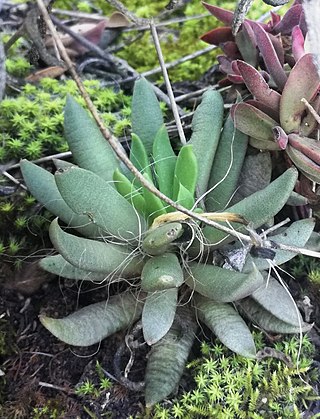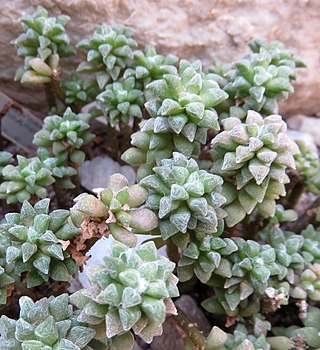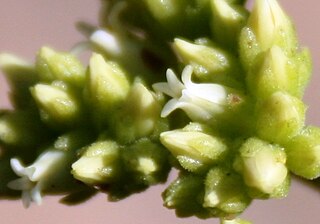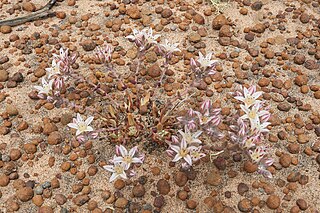
Dudleya lanceolata is a succulent plant known by the common name lanceleaf liveforever or lance-leaved dudleya. It is an extremely variable and widely ranging species that occurs from Monterey County and Kern County in California south through Ensenada in Baja California. It is characterized by green to purple lanceolate leaves, red, orange, or less commonly yellow petals, and is typically tetraploid. Despite its diversity, it is quite stable as a species, but hybrids may be discovered with other species of Dudleya, which can make it difficult to discern in areas where numerous species converge.

Brunfelsia pauciflora is a species of flowering plant in the family Solanaceae, the nightshades. It is endemic to Brazil, and it is grown in cultivation. A shrubby perennial plant grown in gardens, its common names include today, tomorrow together, yesterday, today and tomorrow, morning-noon-and-night, kiss me quick, and Brazil raintree.

AnacampserosL. is a genus comprising about a hundred species of small perennial succulent plants native to Southern Africa, Ethiopia and Latin America. The botanical name Anacampseros is an ancient one for herbs supposed to restore lost love.

Lapidaria is a monotypic genus of dwarf succulent plants in the family Aizoaceae. The only species it contains is Lapidaria margaretae, also known as the Karoo rose.

Dudleya attenuata is a species of perennial succulent plant known by the common name taper-tip liveforever, native to Baja California and a small portion of California. A rosette-forming leaf succulent, it has narrow pencil shaped leaves that can often be found covered in a white epicuticular wax. The thin, sprawling stems branch to form the clusters of rosettes, with plants creating a "clump" up to 40 cm wide. The small flowers are white or yellow, with 5 spreading petals. It is a diverse, variable species that extends from the southernmost coast of San Diego County to an area slightly north of the Vizcaino Desert, hybridizing with many other species of Dudleya in its range. Some plants with white or pinkish flowers were referred to as Orcutt's liveforever, referring to a former subspecies split on the basis of the flower color.

Crassula cotyledonis is a succulent plant endemic to the arid Namaqualand and Karoo regions of South Africa.

Boscia foetida, commonly known as the stink shepherd's tree and the smelly shepherd's bush, is an evergreen shrub or tree that is native to the warmer and drier parts southern Africa. It is found in semi-desert and arid bushveld, and in the west it occurs commonly in areas which are otherwise sparsely wooded. It is known for the particularly unpleasant smell of its flowers which appear during early spring, to which its specific name foetida alludes. Its freshly cut wood likewise has an unpleasant smell, and has traditional medicinal and magical uses, for instance as a protection against lightning. In central Botswana the village of Mopipi is named after this species.

Anacampseros lanceolata is a species of succulent plant native to the western Karoo and Overberg regions of South Africa.

Anacampseros arachnoides is a species of succulent plant native to the Little Karoo region of South Africa.

Anacampseros albidiflora is a species of succulent plant native to the Great Karoo and Little Karoo regions of South Africa.

Anacampseros telephiastrum is a species of succulent plant native to the southern Karoo region of the Western Cape and Eastern Cape Provinces of South Africa, from Robertson in the west, to Somerset East in the east.

Crassula subaphylla is a succulent plant belonging to the family Crassulaceae. It is widespread in the Karoo regions of South Africa and Namibia.

Crassula atropurpurea is a succulent plant, very common and widespread in the southern Karoo regions of South Africa and Namibia.

Pelargonium coronopifolium is a subshrub of up to 40 cm high. It has green to slightly greyish, linear to narrowly elliptical leaves often with irregular teeth towards the tip and white to purple flowers in groups of one to four. It can be found in the Western Cape province of South Africa. Old publications suggested the name buck's horn plantain-leaved stork's bill, but this name never gained common use.

Dudleya campanulata is a species of perennial succulent plant known by the common name as the Punta Banda liveforever, native to Baja California and endemic to the Punta Banda peninsula, a promontory south of Ensenada that encloses the southern limit of the Bahía de Todos Santos, a deepwater bay. One of many species of Dudleya native to the peninsula and surrounding islands, it is distinguished by its campanulate flowers and its occupation of a narrow habitat that consists of ocean bluffs on the southern end of the Punta Banda, near the well-known blowhole La Bufadora.

Dudleya crassifolia is a species of drought deciduous, corm-forming succulent plant known by common name as the thick-leaf dudleya. It is an incredibly rare and cryptic plant native to one small locale less than a hectare in area on the Colonet peninsula in Baja California. It is threatened by urban development, including a proposed seaport. It is characterized by white, spreading flowers with leaf bases that are persistent on the stem. Although it did not receive as much media attention as the neighboring Dudleya hendrixii, it has been noted that the plant has several similarities to cryptic succulents like Anacampseros.

Dianthus thunbergii is a species of flowering plant in the family Caryophyllaceae.

Tylecodon reticulatus is a species of succulent plant in the genus Tylecodon belonging to the family Crassulaceae.

Tylecodon paniculatus, also known as butter bush, butter tree, butterboom or rooisuikerblom (Afrikaans), is a species of succulent plant in the genus Tylecodon belonging to the family Crassulaceae.

Babiana bainesii is a species of geophyte of 15–25 cm (5.9–9.8 in) high that is assigned to the family Iridaceae. It sometimes grows in tufts. The approximately upright leaf blades appear directly from the ground, are narrow, sword- to line-shaped and have a left and right surface, rather than an upper and lower surface, and far exceed the flowers in length. The leaf blades are pleated. The inflorescence stem is fully underground and often branched. It contains two to eight blue, violet or mauve mirror-symmetrical flowers comprising six tepals. B. bainesii has a wide distribution and occurs in Botswana, Namibia, South Africa, southernmost Zambia and Zimbabwe.






















